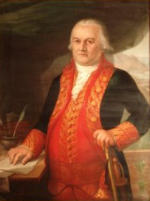Battle of Collioure
| Battle of Collioure | |
|---|---|
| Part of the Pyrénées Orientales, France | |
| Result | Spanish victory |
The Battle of Collioure (20–23 December 1793) saw troops from
Background
In the year 1793 the
On 18 September
Turreau's application for transfer finally came through and the representatives named Aoust temporary commander from 22 November.[7] François Amédée Doppet assumed command of the army on 28 November.[2] Doppet found the army in a terrible state, the men badly equipped and the horses and mules dying from lack of feed. The representatives practically ignored Doppet, issuing orders without informing him of the actions of his own units. On 6 December, Doppet received information that the Spanish planned to attack Villelongue-dels-Monts the next day and tried to warn the garrison. Paying no heed to their commander, the defenders set out to attack the Spanish. The result was a fiasco; the French were routed and the Spanish captured Villelongue.[7]
In order to break contact with the enemy and draw his army back into winter quarters, Doppet planned an attack on Villelongue. The representatives chose Aoust to lead the assault, which was launched on the evening of 18 December and was a success.
Battle

After his success on 7 December 1793, Ricardos planned to evict the French from the coastal towns, Collioure and Port-Vendres. He sent the division of Juan de Courten to the south side of the Pyrenees at Espolla. While José de Iturrigaray and the Spanish cavalry distracted the enemy near Argelès-sur-Mer, Courten was ordered to attack the French position near the Col de Banyuls (Banyuls Pass). On 14 December the attack was made by six or seven columns that each crossed the Pyrenees by different passes. The attempt was a success and Delattre's troops were compelled to abandon their positions after the Spanish captured 300 French soldiers and 20 field pieces. This action forced Delattre's division into a narrow corridor along the coast. Gregorio García de la Cuesta replaced Courten in command a few days later. The new commander saw that Collioure could be approached by three defiles through rough terrain.[10]
Delattre deployed his men on a ridge covering both Collioure and Port-Vendres.[11] Cuesta formed his troops into columns under Castrillo, Ortig and Solano and attacked. All three columns broke through, the French defenders fleeing in the direction of their coastal forts.[10] As the retreating French approached Fort Saint-Elme and Port-Vendres, both places shut their gates, refusing to admit the soldiers. Fort Saint-Elme even fired on them. Feeling betrayed, large numbers of men surrendered to the pursuing Spanish troops.[11] Saint-Elme's traitorous commander immediately surrendered the fort[9] as soon as Solano summoned it. Ortig called for the surrender of Port-Vendres and it also capitulated.[10] The remaining French troops sought refuge in Collioure or tried to break out by fighting their way north along the coast. Delattre escaped but Fabre was killed, dying bravely at the front of one of the columns.[11] Cuesta sent three battalions to approach Collioure at night with torches, threatening to burn the place. It surrendered as well.[9][10] The date of the battle is unclear. Two sources stated that the engagement happened on 20 December.[9][12] Another authority asserted that the fighting occurred on the 21st.[11] A final source put the date of Collioure's surrender as 23 December.[13]
Results

The French suffered losses of 4,000 men killed, wounded or captured out of a total of 5,000. Between the army and the coastal forts the Spanish captured 100 artillery pieces. Cuesta's 8,000-man force sustained only 300 casualties.
Since all the other French armies had been successful by the end of 1793, the
Notes
- Footnotes
- ^ The text suggested the 7,700 included the losses at Collioure, but was not specific.
- Citations
- ^ Phipps 2011, p. 169.
- ^ a b c d Clerget 1905, p. 23.
- ^ Broughton 2006b.
- ^ Phipps 2011, pp. 154–155.
- ^ Phipps 2011, pp. 156–157.
- ^ Phipps 2011, pp. 158–161.
- ^ a b Phipps 2011, pp. 162–164.
- ^ Phipps 2011, p. 165.
- ^ a b c d e f Phipps 2011, p. 166.
- ^ a b c d Cust 1859, p. 170.
- ^ a b c d Rickard 2009.
- ^ a b Smith 1998, p. 64.
- ^ a b c Cust 1859, p. 171.
- ^ a b c Phipps 2011, p. 167.
- ^ Broughton 2006a.
- ^ Broughton 2007.
- ^ Phipps 2011, p. 168.
- ^ Phipps 2011, p. 171.
References
- Broughton, Tony (2006a). "Generals Who Served in the French Army during the Period 1789-1815: Abbatucci to Azemar". The Napoleon Series. Retrieved 7 September 2015.
- Broughton, Tony (2007). "Generals Who Served in the French Army during the Period 1789-1815: De Das de l'Aulne to De Winter". The Napoleon Series. Retrieved 7 September 2015.
- Broughton, Tony (2006b). "Generals Who Served in the French Army during the Period 1789-1815: Fabre to Fyons". The Napoleon Series. Retrieved 7 September 2015.
- Clerget, Charles (1905). Tableaux des Armées Françaises pendant les Guerres de la Révolution. Paris: Librarie Militaire R. Chapelot et Cie. Retrieved 7 September 2015.
- Cust, Edward (1859). "Annals of the Wars: 1783-1795". Retrieved 7 September 2015.
- ISBN 978-1-908692-26-9.
- Rickard, J (2009). "Combat of Collioure, 21 December 1793". historyofwar.org. Retrieved 7 September 2015.
- ISBN 1-85367-276-9.
